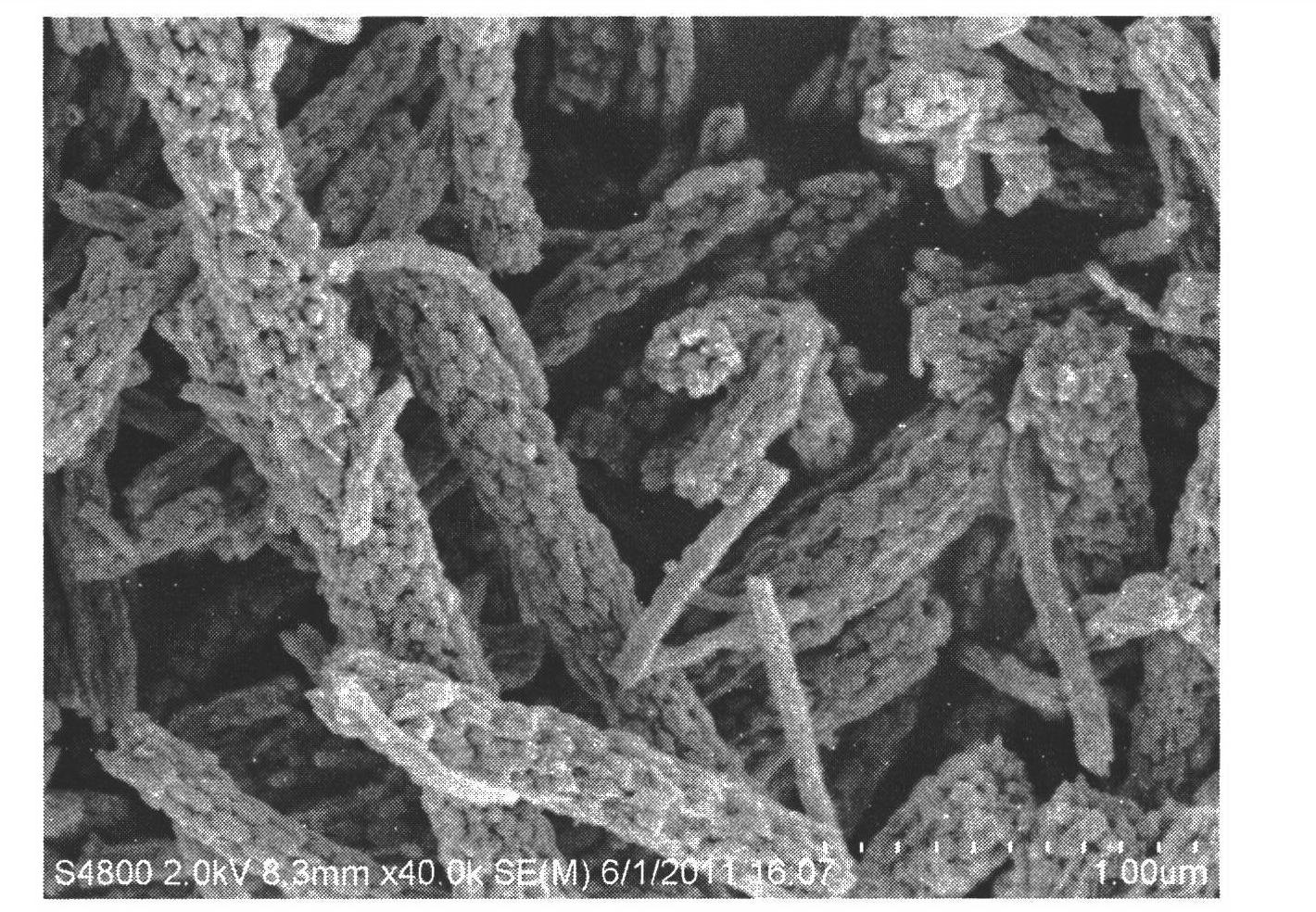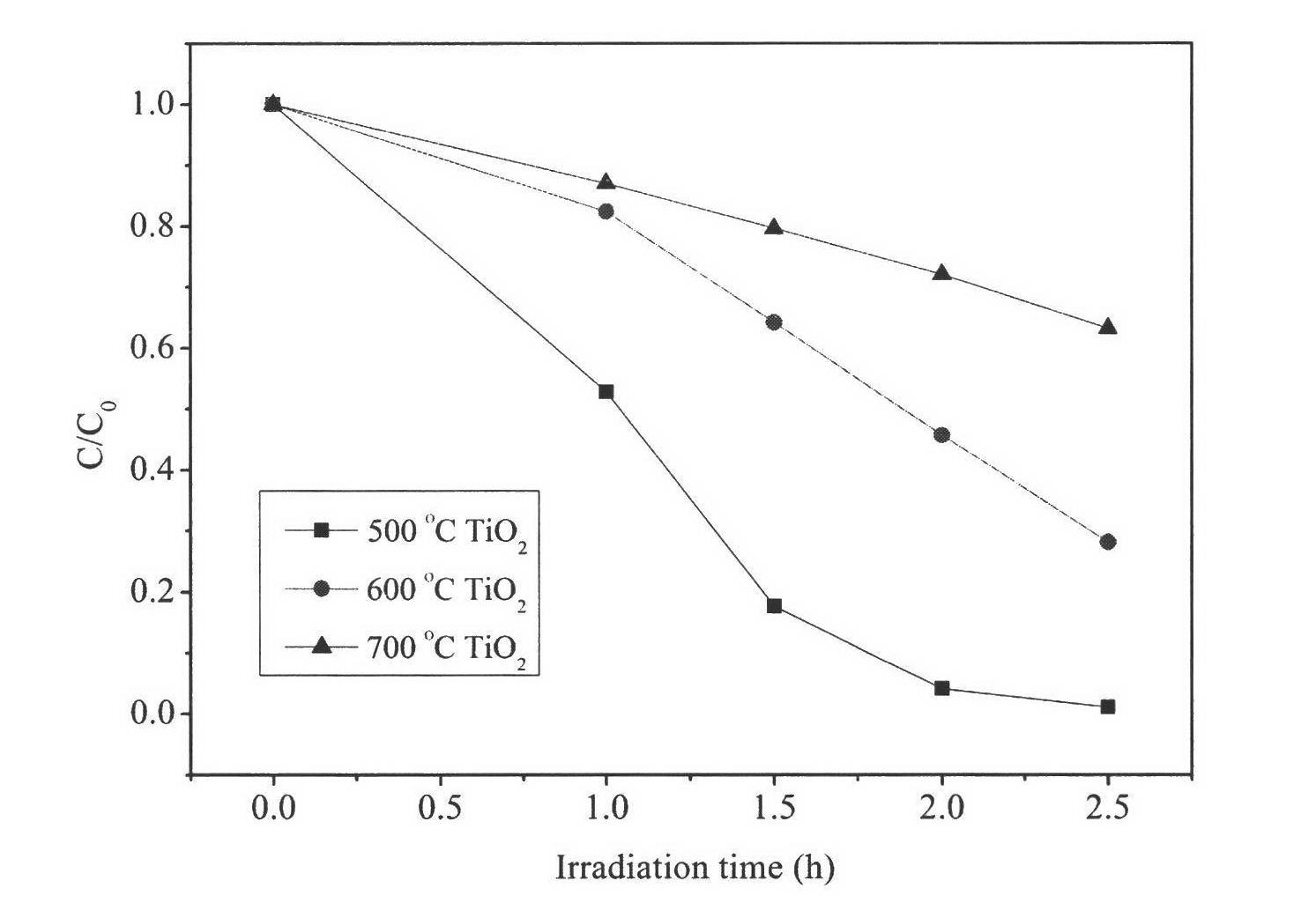Anatase type titanium dioxide nano-fiber photocatalyst and preparation method thereof
A nanofiber and titanium dioxide technology, which is applied in the field of nanomaterials and photocatalysis, can solve the problems of uneven particle size of titanium dioxide, increase the difficulty of process adjustment, and poor control of crystallinity, and achieve uniform particle size and easy control of the preparation process , the effect of small granularity
- Summary
- Abstract
- Description
- Claims
- Application Information
AI Technical Summary
Problems solved by technology
Method used
Image
Examples
Embodiment 1
[0018] Weigh PVP 0.76g, TBT 6.81g (PVP / TBT=1:9); PVP 1.70g, TBT 6.81g (PVP / TBT=2:8); PVP 2.92g, TBT 6.81g (PVP / TBT=3 : 7), and then respectively added to 3 parts of 9.21g absolute ethanol solution, added a magnetic stirrer, adjusted to an appropriate speed, and stirred at room temperature for 4 to 6 hours. The prepared above-mentioned spinning solution is packed into a syringe with a ground stainless steel needle, and the syringe is installed on the electrospinning device. At a spinning voltage of 10kV, the distance between the receiving device and the spinneret is 15cm, and the spinning Under the process condition of liquid flow rate of 0.5mL / h, spinning for 10h, PVP / TBT composite nanofiber membrane was obtained. The obtained composite nanofiber membrane was put into a muffle furnace, heated from room temperature to 400 °C at a heating rate of 0.5 °C / min, calcined for 5 h, and then naturally cooled to room temperature.
Embodiment 2
[0020] Weigh PVP 0.76g, TBT 6.81g (PVP / TBT=1:9); PVP 1.70g, TBT 6.81g (PVP / TBT=2:8); PVP 2.92g, TBT 6.81g (PVP / TBT=3 : 7), and then respectively added to 3 parts of 9.21g absolute ethanol solution, added a magnetic stirrer, adjusted to an appropriate speed, and stirred at room temperature for 4 to 6 hours. The prepared above-mentioned spinning solution is packed into a syringe with a ground stainless steel needle, and the syringe is installed on the electrospinning device. At a spinning voltage of 12kV, the distance between the receiving device and the spinneret is 15cm, and the spinning Under the process condition of liquid flow rate of 1mL / h, spinning for 10h, the PVP / TBT composite nanofiber membrane was obtained. The obtained composite nanofiber membrane was put into a muffle furnace, heated from room temperature to 500 °C at a heating rate of 1 °C / min, calcined for 4 h, and then naturally cooled to room temperature.
Embodiment 3
[0022] Weigh PVP 0.76g, TBT 6.81g (PVP / TBT=1:9); PVP 1.70g, TBT 6.81g (PVP / TBT=2:8); PVP 2.92g, TBT 6.81g (PVP / TBT=3 : 7), and then respectively added to 3 parts of 9.21g absolute ethanol solution, added a magnetic stirrer, adjusted to an appropriate speed, and stirred at room temperature for 4 to 6 hours. The prepared above-mentioned spinning solution is packed into a syringe with a ground stainless steel needle, and the syringe is installed on the electrospinning device. At a spinning voltage of 15kV, the distance between the receiving device and the spinneret is 20cm, and the spinning Under the process condition of liquid flow rate of 0.5mL / h, spinning for 10h, PVP / TBT composite nanofiber membrane was obtained. The obtained composite nanofibrous membrane was put into a muffle furnace, the temperature was raised from room temperature to 500 °C at a rate of 2 °C / min, calcined for 3 h, and then naturally cooled to room temperature.
PUM
 Login to View More
Login to View More Abstract
Description
Claims
Application Information
 Login to View More
Login to View More - R&D
- Intellectual Property
- Life Sciences
- Materials
- Tech Scout
- Unparalleled Data Quality
- Higher Quality Content
- 60% Fewer Hallucinations
Browse by: Latest US Patents, China's latest patents, Technical Efficacy Thesaurus, Application Domain, Technology Topic, Popular Technical Reports.
© 2025 PatSnap. All rights reserved.Legal|Privacy policy|Modern Slavery Act Transparency Statement|Sitemap|About US| Contact US: help@patsnap.com



